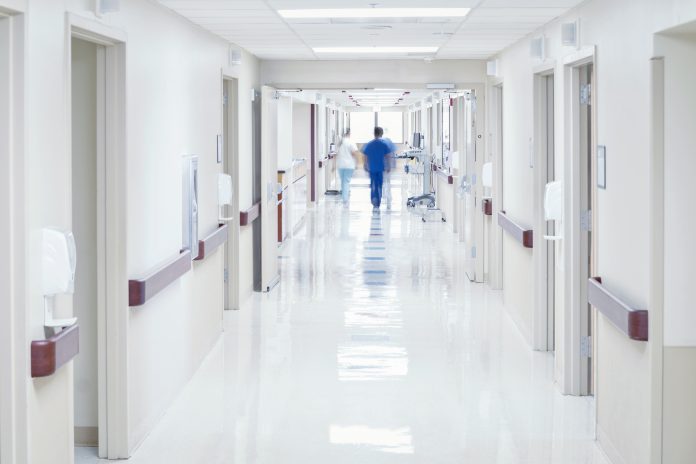Taking into account budget constraints, net zero commitments and the wellbeing of occupants, construction professionals must consider developing more sustainable healthcare facilities. Steve Richmond of REHAU Building Solutions discusses how healthy design principles are key
Hospital construction is very much in the spotlight as the National Audit Office plans to look into the government’s pledge of constructing 40 new hospitals by 2030. With questions raised over costs in the face of spiralling inflation, this is an issue that also resonates with building professionals taking on healthcare developments.
Given that healthcare facilities account for around 4.6% of global carbon emissions, there is also mounting pressure to adopt sustainable measures in line with net zero targets.
While taking all of the above on board, the wellbeing of patients and staff alike needs to be prioritised. Indeed, recent reports go to show that there is a direct link between poor healthcare environments and increased levels of stress and anxiety. As such, it is more important than ever to ensure that healthcare facilities are “healthy by design” in the context of both occupant wellbeing and environmental impact.
How can construction professionals approach the design of sustainable healthcare facilities?
With all these factors to consider, it is important to gain insight into what construction professionals deem to be priorities for building design. It is for this reason that REHAU conducted a survey of 520 M&E designers and architects as part of its Designing Healthy series.
Understandably, sustainability was of utmost importance to contractors when queried on their top priorities in specifying building materials – shortly followed by cost. Nevertheless, 98% were willing to pay extra for a product with a longer expected lifespan. Moving forward, implementing resilient, healthy design features will be key to economic development that doesn’t lose sight of sustainability and occupant wellbeing.
Offsite construction as the new standard for building healthcare facilities
As a starting point, offsite construction has the potential to become the new industry standard when building healthcare facilities. Proven to be faster than its on-site counterpart, it enables lower embodied emissions for the build and mitigates noise pollution for building occupants. Moreover, offsite construction can aid in delivering enhanced quality control along with lowered project costs.
Such a combination of factors certainly makes a strong argument for this technique. Furthermore, REHAU’s survey revealed that 58% believed that demand for offsite construction methods will increase in light of the recent pandemic – another sign that new approaches to healthcare construction should be adopted.
District heating in healthcare facilities
Heating and cooling of the facility itself constitutes a significant portion of the energy demand in the healthcare sector. As such, greener methods of heat provision will be vital to meeting net zero targets.
District heating is one such application that aligns with this aim, yet generational technology plays a part here. As of now, fourth generation networks hold the most potential as they circulate water at 40C-60C for lower heat losses and greater carbon savings.
District heating networks distribute heat and hot water via steel or polymer pre-insulated pipes that are buried under ground. Building professionals should keep in mind that the lower temperature of fourth generation systems makes them better suited to polymer solutions, as opposed to steel.
Acoustic performance in healthcare projects
Acoustics stand as a key consideration in healthcare projects – demonstrated by 91% citing that it was either ‘important’ or ‘very important’ in REHAU’s survey. Research from King’s College London points to underlying reason for these results, indicating that noise levels in intensive care units regularly exceed 100 decibels.
While it is probable that most noise stems from general hospital activity, building services pose another source of noise that, importantly, can be minimised with effective design and specification. A prime example here is the disposal of wastewater as it passes through soil and waste pipework, which can be disruptive to those situated in nearby rooms. In these scenarios, solutions such as REHAU’s RAUPIANO PLUS offer 17dB(A) performance at flow rates of 4l/s to virtually eliminate sounds of running water or vibrations.
Safe drinking water is key for occupant wellbeing
Provision of safe drinking water is another significant factor for occupant wellbeing. Avoiding contamination from both internal and external sources is paramount to upholding the health of patients and staff alike.
Given that metal is the traditional material of choice for this application, the most commonly specified materials for heating and water pipe installations are copper and steel, However, recent findings suggest that other materials are becoming increasingly considered.
Notably, 83% of respondents to REHAU’s survey claimed that they still specified fittings containing lead, which can leach into drinking water supply if pipework is not properly maintained. With this in mind, there may be scope for multilayer composite pipe (MLCP) to prove an effective successor to metal pipework.
Healthcare facilities that are futureproofed by design
REHAU’s report has revealed how the concerns of sustainability, cost-effectiveness and wellbeing weigh up against each other across project builds. While balancing these priorities is certainly challenging, innovative approaches can help construction professionals to create healthcare facilities that are futureproof by design.
To download REHAU’s full report, Designing Healthy Healthcare, click here.
Steve Richmond
Head of marketing and technical
REHAU Building Solutions
Tel: +44 (0)1989 762600





![[VIDEO] Making DorTrak reports easy to read with Fireco Inspecting fire doors at Fireco, firedoor technology, 2023](https://www.pbctoday.co.uk/news/wp-content/uploads/2024/04/JPZ_2364-web-218x150.jpg)
![[VIDEO] Re-flow Field Management review by Traffic Management Installations When TMI began subcontracting for councils and government bodies, they wanted to present their site reporting in a more professional manner](https://www.pbctoday.co.uk/news/wp-content/uploads/2025/03/TMI-Media-1-218x150.png)







